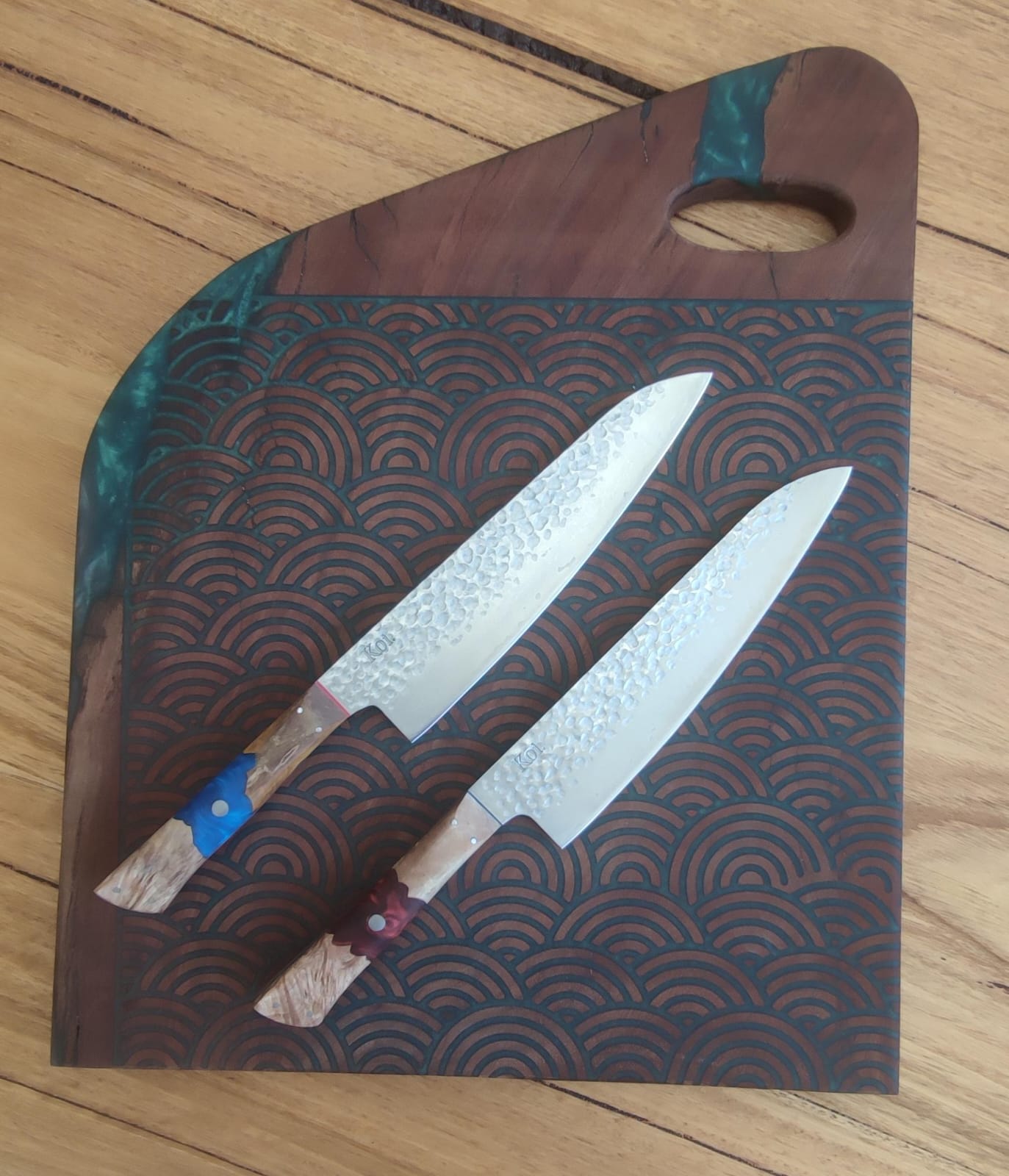If you're as passionate about knives as we are, you've probably noticed that not all blades look the same. Those ripples on one, the bamboo-like pattern on another, and the smoothness of yet another - what's the story behind these differences? That's what we're here to explore.
In this article, we delve into the artistry and functionality of knife finishes, focusing on three exceptional models: Seki, Osaka, and Yokohama. These knives are more than mere kitchen tools; they blend craftsmanship and science. By the end of this post, you'll understand their visual distinctions and appreciate the purpose and impact of these finishes.
Visual Differences in Finishes
Let's explore the fascinating world of knife finishes, where aesthetics meet functionality. The Seki, Osaka, and Yokohama knives each boast unique visual characteristics that set them apart.
Seki Finish: Imagine gazing at a clear night sky. The Seki finish resembles the dark, starry expanse with its smooth, polished surface. It's sleek and minimalist, often showcasing the knife's pristine steel core. This finish is like a timeless tuxedo, exuding understated elegance.
Osaka Ripple: Conversely, Osaka knives sport a distinct ripple pattern that dances along the blade's surface. Like gentle waves, these ripples give the knife a dynamic, fluid appearance. It's akin to having a piece of art in your kitchen, an ever-flowing stream of beauty.
Yokohama Bamboo: Yokohama knives mimic the intricate patterns found in bamboo forests. The blade's surface is etched with lines resembling bamboo shoots. It's like holding a piece of nature's artwork, evoking a sense of tranquillity and harmony.
These visual distinctions make your knives stand out and reflect the rich craftsmanship behind each model.
Purpose of Finishes
Now that we've admired the visual distinctions, let's delve into the fascinating purpose behind these unique finishes—ripple and bamboo.
Significance of Ripple and Bamboo Finishes
The ripple finish, as seen in Osaka Knives, is for more than just show. It's a result of meticulous craftsmanship. The ripples serve a dual purpose: aesthetics and functionality. They enhance the knife's visual appeal, making it a work of art in your kitchen. But they're not just pretty; they create minute air pockets during cutting, reducing friction and helping food release effortlessly.
Yokohama knives, on the other hand, showcase the bamboo finish. Beyond its striking appearance, the bamboo pattern isn't there by chance. Artisans carefully etch these lines into the blade. They serve as a visual tribute to nature and minimise the contact area during slicing. This reduces the chance of food sticking to the blade, offering precision and ease in your culinary endeavours.
Impact on Cutting Performance
The ripple and bamboo finishes have a profound impact on cutting performance. As you slice through food, the ripples and bamboo lines create small air pockets. This reduces drag, allowing you to cut through delicate items like sashimi without tearing or bruising.
Formation of Air Pockets
Imagine cutting paper with a pair of scissors. The smoother the blades, the harder it is to separate the paper. Similarly, a polished edge might need help to cut through moist or sticky ingredients. Here's where these finishes shine—they introduce tiny gaps of air, preventing food from sticking to the blade and giving you the precise control, you need in the kitchen.
Aesthetic Considerations
The ripple and bamboo finishes are not just about functionality but also a feast for the eyes.
Aesthetic Appeal: The ripple finish, with its undulating patterns reminiscent of flowing water, brings a touch of artistry to your kitchen. It's a visual symphony, a subtle yet mesmerizing design that elevates your knife from a mere tool to a work of functional art. On the other hand, the bamboo finish, with its finely etched lines, evokes the grace of nature. It's like holding a piece of a bamboo forest in your hand.
Contributions to Look and Feel: These finishes aren't just surface-deep. They enhance your tactile experience. With its textured surface, the ripple finish offers a secure grip and a tactile sensation that's both functional and delightful. With its smooth, linear pattern, the bamboo finish feels sleek and sophisticated, adding a touch of elegance to your culinary journey.
Cultural and Historical Significance: These finishes have deep roots in Japanese culture. The ripple finish's flowing patterns are a nod to the importance of water in Japanese life, while bamboo has been a symbol of resilience and flexibility. Understanding this cultural significance adds layers of appreciation to your knife.
Functional Considerations
The grip and handling of a knife can make or break your culinary experience.
Grip and Handling
- The Seki's smooth finish provides a sleek grip, suitable for precise cuts.
- Osaka's ripple finish offers a textured grip, enhancing control during chopping.
- Yokohama's bamboo finish, with its ridges, offers a firm hold, ideal for robust tasks.
Functional Advantages
- Seki: Great for delicate slicing due to its smoothness.
- Osaka: Perfect for those who prefer extra grip for accuracy.
- Yokohama: Ideal for heavy-duty tasks where a secure grip is vital.
Functional Disadvantages
- Seki: May feel slippery during wet tasks.
- Osaka: Texture might be uncomfortable for some during prolonged use.
- Yokohama: The ridges can trap food particles, requiring thorough cleaning.
Consider your cooking style and comfort when choosing a knife finish tailored to your needs.
Summary of Differences in Finishes
So, let's sum it up. Regarding Seki, Osaka, and Yokohama knives, the finishes are not just about aesthetics but also about function.
Seki knives typically showcase a Damascus D67 finish characterised by distinctive ripples. This finish adds a touch of elegance and creates air pockets, reducing drag while cutting. Ideal for precision slicing.
Osaka knives sport a Ripple finish, designed for both form and function. The ripples, akin to flowing water, look stunning and minimise food sticking to the blade, making these knives perfect for versatile kitchen tasks.
Yokohama knives, with their Bamboo finish, offer an exotic appearance. This finish minimises drag, much like Seki, but adds a unique visual flair.
Remember, your chosen finish should align with your cooking style and preferences.
Final Thoughts
We've dissected the visual disparities in Seki, Osaka, and Yokohama knives, delved into the purpose behind these intricate finishes, and deciphered how they impact your culinary journey.
Now, the takeaway is clear - when you're hunting for that perfect knife, don't just consider its blade but also the finish that adorns it. The ripple and bamboo finishes aren't merely ornamental; they're functional elements that can elevate your cutting experience.
So, dear reader, as you embark on your knife-buying quest, remember this: each ripple and bamboo pattern tell a story of craftsmanship and utility. Dive deeper, explore, and make choices informed by the rich tapestry of finishes available.




